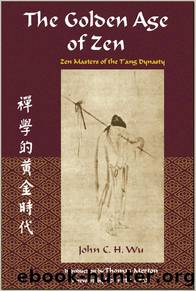The Golden Age of Zen by John C. h. Wu

Author:John C. h. Wu
Language: eng
Format: epub
ISBN: 0-941532-44-5
Publisher: World Wisdom
Footnotes
1. Merton, The Way of Chuang Tzu, p. 27.
2. Ibid., p. 15.
3. The temple on Five-Story Mountain was built in honor of National Teacher Châing-liang, the Fourth Patriarch of the Hua-yen sect. It is said that when he preached on the mountain, a golden-haired lion appeared in the clouds.
Chapter VIII
Outstanding masters in the Lineage
of Shih-tâou:
Tao-wu, Lung-tâan Te-shan,
Yen-tâou and Hsüeh-feng
The five masters whom we are going to treat of in this chapter are important not only because they form a continuous bridge between Shih-tâou, on the one hand, and Yün-men and Hsüan-sha on the other, but because each of them was highly original and had some fresh insights to contribute to the whole tradition of Zen.
Tao-wu of the Tâien-huang Temple (748-807) was born of a Chang family in Wu-chou, Chekiang. When he was fourteen, he felt a vocation to be a monk. As his parents would not hear of it, Tao-wu reduced his diet until he became dreadfully thin and weak. Finally his parents relented and gave their permission. He was professed in his mid-twenties in Hangchow, and was noted for his extreme asceticism. Then he went to Yu-hang to visit Ching-shan Tao-châin (d. 792), who was an outstanding Châan master in the lineage of the Fourth Patriarch Tao-hsin and Niutâou Fa-jung. It was Ching-shan who first initiated Tao-wu into Châan. After serving Ching-shan for five years, he went to visit Ma-tsu, who confirmed him in his insights. After he had spent two summers with Ma-tsu, he went to visit Shih-tâou, asking, âAfter one is freed of Dhyana and Prajna, what Dharma can one show to others?â Shih-tâou said, âIn my place there being no slaves, what is there to be freed from?â âHow is this to be verified?â Tao-wu further inquired. Shih-tâou asked back, âCan you grasp at the empty and void?â âWell,â said Tao-wu, âthis (ungraspability) does not begin today.â Then Shih-tâou asked, âWhen, I wonder, did you come from that place?â âI am not a man of that place!â was Tao-wuâs answer. Shih-tâou said, âI knew long ago where you came from.â Tao-wu replied, âHow can you, master, bring this false charge against me without concrete evidence?â âYour body itself is the present evidence!â said Shih-tâou. âBe that as it may,â said Tao-wu, âmy question still is how to teach the posterity.â Shih-tâou fired back, âTell me who is the posterity?â At this Tao-wu was suddenly enlightened and began to understand thoroughly what his two previous masters had communicated to him.
Tao-wuâs way of teaching can be gathered from how he dealt with his disciple Lung-tâan (died first part of the 9th century). Lung-tâan came from a poor family, who made their living by selling pastry. Tao-wu knew him as a boy, and recognized in him great spiritual potentialities. He housed his family in a hut belonging to his monastery. To show his gratitude, Lung-tâan made a daily offering of ten cakes to the master. The master accepted the cakes, but every day he consumed only nine and returned
Download
This site does not store any files on its server. We only index and link to content provided by other sites. Please contact the content providers to delete copyright contents if any and email us, we'll remove relevant links or contents immediately.
| Baha'i | Cults |
| Demonology & Satanism | Eckankar |
| Egyptian Book of the Dead | Freemasonry |
| Messianic Judaism | Mysticism |
| Scientology | Theism |
| Tribal & Ethnic | Unitarian Universalism |
The Four Agreements by Don Miguel Ruiz(6550)
Breaking Free by Rachel Jeffs(4121)
The Hatha Yoga Pradipika (Translated) by Svatmarama(3187)
120 Days of Sodom by Marquis de Sade(3124)
Member of the Family by Dianne Lake(2282)
The Tao of Physics by Fritjof Capra(2208)
The Psychedelic Gospels: The Secret History of Hallucinogens in Christianity by Jerry B. Brown(2097)
The Road to Jonestown by Jeff Guinn(2000)
Going Clear: Scientology, Hollywood, and the Prison of Belief by Lawrence Wright(1912)
Going Clear by Lawrence Wright(1897)
Uriel's Machine by Christopher Knight(1843)
The Grand Grimoire: The Red Dragon by Author Unknown(1736)
The Gnostic Gospel of St. Thomas by Tau Malachi(1715)
Key to the Sacred Pattern: The Untold Story of Rennes-le-Chateau by Henry Lincoln(1576)
The Malloreon: Book 02 - King of the Murgos by David Eddings(1534)
Waco by David Thibodeau & Leon Whiteson & Aviva Layton(1509)
The New World Order Book by Nick Redfern(1507)
The Secret of the Temple by John Michael Greer(1443)
Animal Speak by Ted Andrews(1425)
